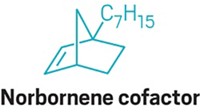Advertisement
Grab your lab coat. Let's get started
Welcome!
Welcome!
Create an account below to get 6 C&EN articles per month, receive newsletters and more - all free.
It seems this is your first time logging in online. Please enter the following information to continue.
As an ACS member you automatically get access to this site. All we need is few more details to create your reading experience.
Not you? Sign in with a different account.
Not you? Sign in with a different account.
ERROR 1
ERROR 1
ERROR 2
ERROR 2
ERROR 2
ERROR 2
ERROR 2
Password and Confirm password must match.
If you have an ACS member number, please enter it here so we can link this account to your membership. (optional)
ERROR 2
ACS values your privacy. By submitting your information, you are gaining access to C&EN and subscribing to our weekly newsletter. We use the information you provide to make your reading experience better, and we will never sell your data to third party members.
Synthesis
Reaction regioselectivity doesn’t require a transition state
Solvent dynamics are key to preferential nitration of toluene at ortho and para ring positions
by Jyllian Kemsley
November 21, 2016
| A version of this story appeared in
Volume 94, Issue 46
Toluene nitration by nitronium (NO2+) salts yields curious regioselectivity: Although nitration should occur equally at all positions of the ring because the reaction is highly exothermic and the energy barrier is near zero, only 2% of the products are substituted at the meta position. Of various mechanisms proposed to explain this selectivity, none has proven to be satisfactory. That is because the reaction involves no intermediates and no transition states beyond the initial encounter of toluene and nitronium, according to computational work by Yexenia Nieves-Quinones and Daniel A. Singleton of Texas A&M University (J. Am. Chem. Soc. 2016, DOI: 10.1021/jacs.6b07328). The researchers find that after the toluene and nitronium encounter each other, they don’t immediately react. Instead, the nitronium wanders around the area above the aromatic carbons until random fluctuations reorient the counterion and solvent molecules, from stabilizing nitronium to stabilizing the product cation. Once that reorganization occurs, the nitronium faces downhill paths for reacting with any of the carbons—but the paths for ortho or para substitution are steeper and easier to access than for meta or ipso substitution.





Join the conversation
Contact the reporter
Submit a Letter to the Editor for publication
Engage with us on Twitter